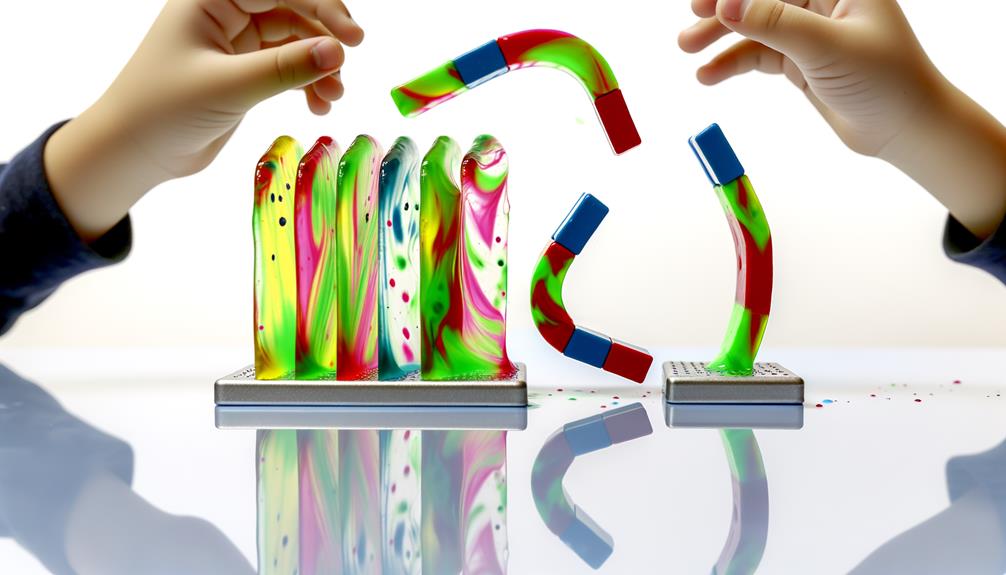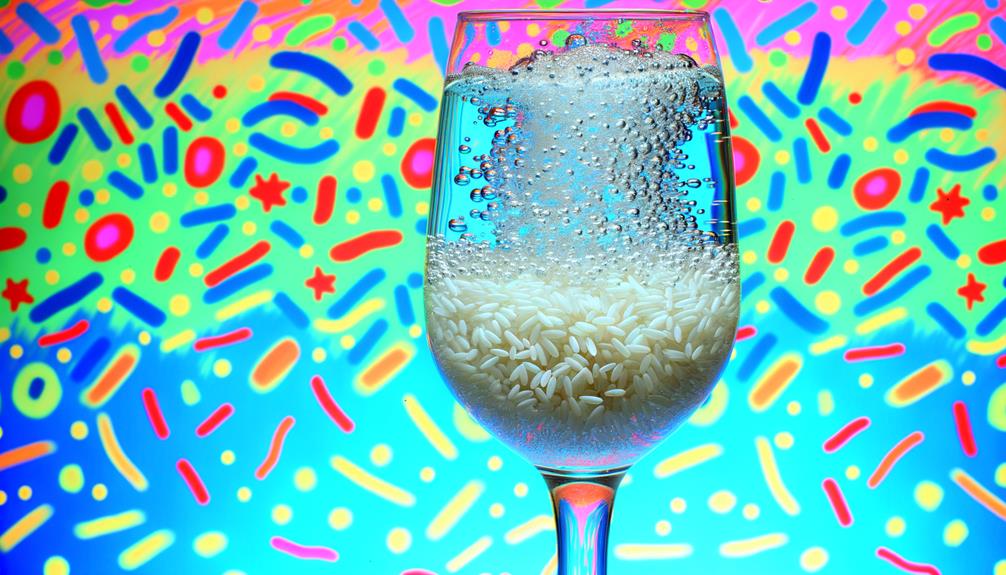Release your inner scientist with these five enchanting chemistry experiments that you can easily do at home! Watch in awe as colorful water climbs up paper towels, create your own fizzy volcano eruption, and play with magnetic slime that moves like magic. Uncover secret messages using invisible ink and witness rice dance in a bubbly chemical reaction. These hands-on activities will not only entertain your kids but also teach them fascinating scientific concepts. Get ready to explore the wonders of capillary action, chemical reactions, magnetism, and more as you begin this exciting journey into the world of chemistry.
Colorful Capillary Action
Have you ever wondered how plants transport water from their roots to their leaves? It's all thanks to capillary action! You can observe this fascinating phenomenon with a simple experiment using paper towels and food coloring.
Cut a paper towel into strips and place one end of each strip in a shallow dish filled with water and a few drops of different food coloring. Watch as the colored water travels up the paper towel, creating a beautiful rainbow effect.
Capillary action occurs when the adhesive force between the water and the paper towel is stronger than the cohesive force within the water itself. This allows the water to "climb" up the tiny spaces between the paper towel fibers, defying gravity.
In plants, this same process takes place in narrow tubes called xylem, which transport water and nutrients from the roots to the leaves.
Fizzy Baking Soda Volcano
Ready for an explosive science experiment? You can create your own fizzy baking soda volcano with just a few household ingredients.
First, place an empty plastic bottle on a tray or dish. Next, mix equal parts of baking soda and water in a separate container until you have a paste-like consistency. Pour this mixture into the bottle.
Now, in another container, mix equal parts of vinegar and liquid dish soap. When you're ready for the eruption, pour the vinegar mixture into the bottle containing the baking soda paste.
Watch as the chemical reaction between the baking soda and vinegar creates a foamy, fizzy "lava" that flows out of the bottle! You can add food coloring to the vinegar mixture for a more vibrant display.
Experiment with different amounts of baking soda and vinegar to see how it affects the size and duration of the eruption. This hands-on activity is a fun way to introduce kids to the basics of chemical reactions and the properties of different substances.
Just remember to do this outside or in a well-ventilated area for easy cleanup.
Magnetic Slime Adventure

Get ready for a slimy, magnetic adventure that's both fun and educational! You'll need white school glue, liquid starch, iron oxide powder, and a strong neodymium magnet.
Mix 1/4 cup of white glue with 1 tablespoon of iron oxide powder in a bowl. Stir until the powder is evenly distributed. Slowly add 1/4 cup of liquid starch to the mixture, stirring continuously. As the slime forms, knead it with your hands until it's no longer sticky.
Now, hold the magnet near the slime and watch as it's mysteriously attracted to the magnetic field! You can even use the magnet to make the slime move, stretch, and dance without touching it directly.
Experiment with different ways to manipulate the slime using the magnet, and observe how the iron oxide powder within the slime responds to the magnetic force.
This hands-on experiment demonstrates the fascinating properties of magnets and magnetic materials. It's a great way to introduce kids to the basics of magnetism while having a blast playing with their very own magnetic slime creation!
Invisible Ink Messages
Next up, let's explore the world of secret messages with an invisible ink experiment!
You'll need a few simple items: lemon juice, a cotton swab, white paper, and a heat source like a light bulb or candle.
Dip the cotton swab in lemon juice and write your secret message on the paper. Let it dry completely, and the message will disappear.
To reveal the hidden words, hold the paper near the heat source. The heat will cause the lemon juice to oxidize, turning brown and making your message visible.
This experiment works because lemon juice is an organic substance that reacts with heat. When exposed to high temperatures, the compounds in the juice break down and change color.
You can also try this with other acidic liquids like milk, vinegar, or orange juice.
Invisible ink is a fun way to send secret messages and learn about chemical reactions. Experiment with different liquids and heat sources to see which works best.
Just be careful when handling heat, and always have an adult supervise.
Dancing Rice Experiment

Let's make rice dance! This simple experiment is a fun way to introduce kids to the concept of chemical reactions. All you need is a clear glass, water, uncooked rice, and baking soda. Here's how to do it:
- Fill the glass about 3/4 full with water and add a handful of uncooked rice.
- Observe how the rice settles at the bottom of the glass.
- Add a tablespoon of baking soda to the water and stir gently.
- Watch in amazement as the rice starts to "dance" up and down in the glass!
The dancing rice experiment works because of a chemical reaction between the baking soda and the water. When baking soda is added to water, it creates tiny carbon dioxide bubbles that attach to the rice grains.
As the bubbles rise, they carry the rice to the surface. When the bubbles pop, the rice sinks back down, creating a mesmerizing dance.
This experiment is a great way to demonstrate the power of chemical reactions and engage kids in hands-on learning about science.
Frequently Asked Questions
What Safety Precautions Should Be Taken When Conducting These Experiments?
When doing chemistry experiments, wear safety goggles and gloves. Work in a well-ventilated area. Have an adult supervise. Don't mix chemicals randomly. Clean up spills immediately. Wash your hands thoroughly when you're done.
Are There Any Alternative Materials That Can Be Used for These Experiments?
You can use alternative materials for these experiments, like substituting vinegar with lemon juice or using plastic containers instead of glass. Just guarantee they're safe and won't react differently than the original materials.
How Can These Experiments Be Adapted for Different Age Groups?
You can adapt these experiments for different ages by simplifying steps for younger kids and adding complexity for older ones. Use age-appropriate explanations and supervision, and adjust materials based on the child's skill level.
What Scientific Principles Are Demonstrated in Each of These Experiments?
You'll learn about density, acid-base reactions, and surface tension. These experiments demonstrate how chemicals interact, showing the exciting and sometimes unexpected ways that substances behave when they come into contact with each other.
How Can These Experiments Be Integrated Into a Homeschool Science Curriculum?
You can easily integrate these experiments into your homeschool science curriculum by aligning them with the scientific concepts you're teaching. They'll provide hands-on learning experiences that reinforce the principles and make science engaging and fun.
Conclusion
You've just scratched the surface of the wondrous world of chemistry! With these five easy experiments, you're on your way to becoming a science superstar. Don't stop here – keep exploring, questioning, and discovering. Who knows what amazing things you'll uncover next? Remember, science is all around you, waiting to be explored. So go ahead, put on your lab coat, and plunge into the exciting domain of chemistry. Your next great discovery awaits!




Leave a Reply